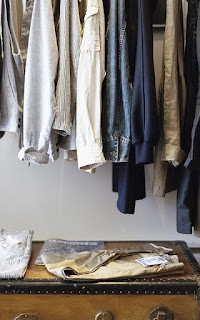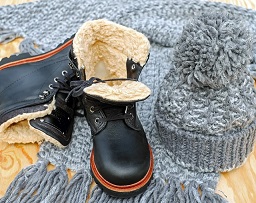With the arrival of winter comes a whole different set of clothes, coats, accessories, and footwear. With that in mind, you don’t want to be reaching into your closet to get a puffy coat, only to come out with a spring jacket!
Keeping your closet in tune with the season makes your life a little easier and a lot more organized.
Figure out an alternate season space
To be really organized, you need a space to store the clothes, accessories, and footwear for the alternate season that is not in your daily use closet space. That goes for any items in entry hall closets and mudrooms too.
Ideally, you’ve got a storage area where you can put away the clothes that are no longer in season, to keep them out of the way and ready to pull out next time around. That could be a rack or cupboard in the basement, vermin and waterproof storage bins in the garage, or any other less-used closet space you have available. Even in a small space, under bed storage boxes can make an easy way to keep your winter wear separate from your summer wear.
Prep and purge
As you look to shift into winter gear, you need to consider making more space. After all, sweaters and coats take a lot more space than t-shirts and shorts. It might be time to give what’s in your closet right now a thorough going over.
Look at everything in your closet and decide on a location for it.
Start with two piles: fall/winter appropriate clothing and spring/summer clothing.
With the second pile, you can go through and then divide it further:
- Clothes that need to be repaired/cleaned and stored away in an ‘alternate season closet. Make sure to actually get that done: just leaving that pile on the floor of the closet until next season isn’t the point!
- Clothes that no longer fit or you never wear can be donated.
- Clothes that are beyond redemption—that ages-old grape juice stain isn’t going to magically come out—and should be tossed.
Now you’ve got room in your closet to manage the first pile:
- Check that every piece is in good repair, is clean, and still fits. If it does, and you want to keep it, find it a home in your closet. If it’s outerwear—including hats, mitts, scarves and boots—that’s best placed in the hall closet or mudroom. Anything else should be sorted and placed in your daily wear closet. If there is any item that is dirty or needs cleaning, get it done and put it away.
- Anything that no longer fits or you won’t wear, donate it.
- Anything left? Toss it.
Store like with like
As with spring/summer clothes, it’s best to have a system for storing your winter wear so that you can lay your hands on what you’re looking for when you need it. Some options:
- Some people prefer to store items according to color schemes so that they can mix and match pieces that work well.
- Another option is to organize by type: pants, shirts, sweaters and so on, all grouped.
- Another idea is to store your clothes according to your usage. So work clothes, casual outfits, workout wear and so on.
Whatever system you use, it only needs to make sense to you!
Cold weather accessories like company
Easy access to accessories is important, never more so than when you’re searching for your favorite cashmere scarf, to keep the cold out.
With mittens, hats, and other outerwear, it’s a good idea to have a basket per type (hats, gloves, scarves) or one per person, which is easier with kids, where these items can be placed and retrieved every day. Hooks for good scarves that shouldn’t be bunched up are also ideal and make sure you have a place to put wet gear—hanging over a heat vent, for example—so they’ll be dry by morning.
Make good use of shelving
You’re more likely to wear something if you see it. If a sweater is buried under three layers of other sweaters in a drawer, you probably won’t pull it out and put it on. Add to that, heavy knits and cable sweaters can really lose their shape if they’re hung. Using shelves for foldable items like these ensures that they’re visible, easy to grab, and remain in good condition. An exception? Lightweight cardigans in crushable fabrics: you might want to hang these to avoid them looking rumpled and tired when you want to wear them.
Hanging shelves are an option if you don’t want to install any, but a good investment in any closet is setting up some custom shelves, rods, drawers, and shoe racks.
It’s not practical to come into the house and store your wet, snowy coats and boots in your bedroom closet, so make sure there is space cleared in the hall closet or mudroom, complete with a drip catcher or mat so that everyone can leave their outerwear and footwear to dry without dripping all over the place, or worse, on your better footwear meant for indoors!
So there you go- happy organizing!




Comments
Post a Comment